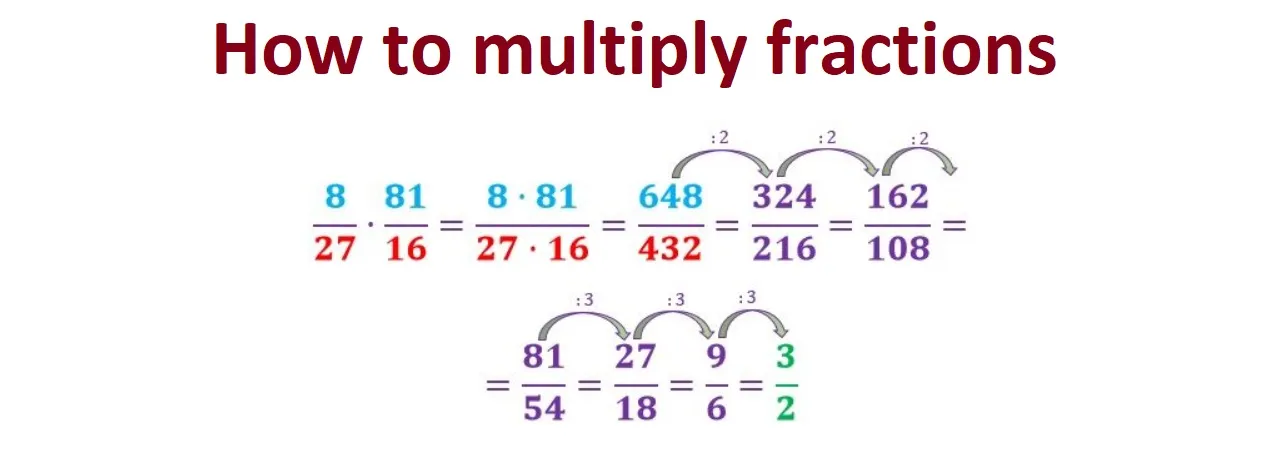Fractions are a fundamental part of mathematics and are used to represent rational numbers. A fraction is a mathematical expression that represents a part of a whole. Fractions are used in everyday life, in areas like finance, construction, and cooking. Knowing how to multiply fractions is important to be able to perform more complex math operations. In this article, we will explain in detail how to multiply fractions.
What are fractions?
A fraction is a mathematical expression that represents a part of a whole. It is made up of two numbers: the numerator, which represents the number of parts being considered, and the denominator, which indicates the total number of parts in the whole. For example, in the fraction 1/4, the numerator is 1 and the denominator is 4. This means that one part of four equal parts is being considered.
Why is it important to know how to multiply fractions?
The multiplication of fractions is a fundamental mathematical operation that is used in everyday life. For example, in the kitchen, it is common to use fractions to measure ingredients. If you need to make a recipe for 6 people and you want to make it for 10, you need to multiply the amount of ingredients by 10/6. In finance, fractions are used to calculate percentages, interest rates, and discounts.
How do you multiply fractions?
To multiply fractions, the following steps must be followed:
- Multiply the numerators of the fractions.
- Multiply the denominators of the fractions.
- Simplify the resulting fraction.
For example, if you want to multiply 1/3 by 2/5, you must follow these steps:
- 1 x 2 = 2
- 3 x 5 = 15
- The resulting fraction is 2/15. This fraction is already simplified, so no further operations are necessary.
How are fractions simplified?
Simplifying a fraction means expressing it in its smallest form. To simplify a fraction, the following steps must be followed:
- Find the greatest common divisor (GCD) of the numerator and the denominator.
- Divide the numerator and denominator by the LCD.
For example, if you want to simplify the fraction 8/24, you must follow the following steps:
- The LCD of 8 and 24 is 8.
- Divide the numerator and denominator by 8.
8/24 = (8 ÷ 8) / (24 ÷ 8) = 1/3The simplified fraction is 1/3.
Fraction Multiplication Examples
Here are some examples of multiplying fractions:
Example 1: 2/3 x 1/4
- 2 x 1 = 2
- 3 x 4 = 12
- The resulting fraction is 2/12, which can be simplified by dividing both terms by 2:
2/12 = (2 ÷ 2) / (12 ÷ 2) = 1/6Therefore, 2/3 x 1/4 = 1/6.
Example 2: 3/5 x 2/3
- 3 x 2 = 6
- 5 x 3 = 15
- The resulting fraction is 6/15, which can be simplified by dividing both terms by 3:
6/15 = (6 ÷ 3) / (15 ÷ 3) = 2/5Therefore, 3/5 x 2/3 = 2/5.
Example 3: 1/2 x 3/4 x 2/3
To multiply three fractions, you can multiply the first two and then multiply the result with the third. So, one has:
- (1/2 x 3/4) x 2/3
- 1 x 3 = 3 and 2 x 4 = 8
- The resulting fraction is 3/8
- 3/8 x 2/3
- 3 x 2 = 6 and 8 x 3 = 24
- The resulting fraction is 6/24, which can be simplified by dividing both terms by 6:
6/24 = (6 ÷ 6) / (24 ÷ 6) = 1/4Therefore, 1/2 x 3/4 x 2/3 = 1/4.
Conclusion
The multiplication of fractions is a fundamental mathematical operation that is used in everyday life. To multiply fractions, you must multiply the numerators and denominators, and then simplify the resulting fraction. Knowing how to multiply fractions is important to be able to perform more complex math operations and to apply fractions in everyday situations, such as cooking and finance. With practice and understanding, multiplying fractions will become easier and more natural.


Do you have any questions or problems related to the topic of the article? We want to help you.
Leave a comment with your problem or question. We read and respond to all comments, although sometimes it may take a while due to the volume we receive. Additionally, if your question inspires the writing of an article, we will notify you by email when we publish it.
*We moderate comments to avoid spam.
Thank you for enrich our community with your participation!